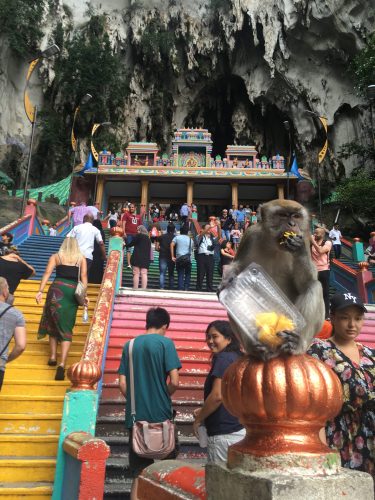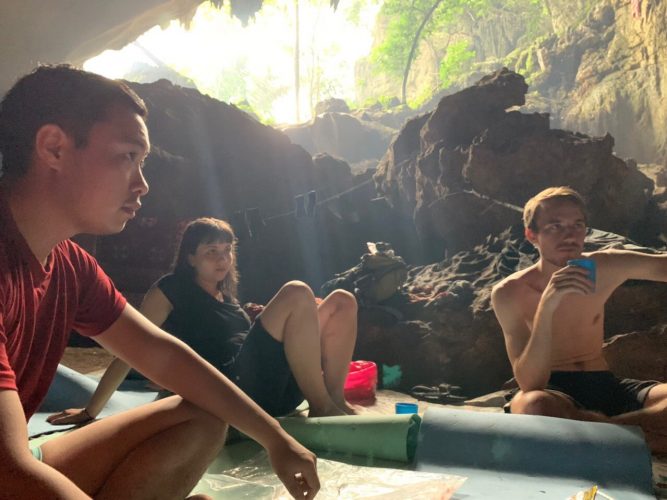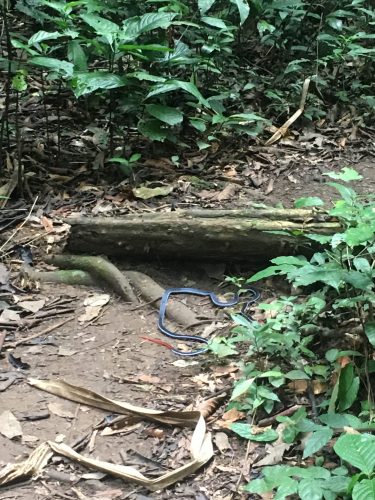Malaysia
Crazy for broccoli
July 23, 2019

After four weeks in Singapore attending the summer school, my friend Emilia joined me to explore more of South-East Asia over the months to come. Our first destination was the country which has been and still is of prime importance to Singapore – Malaysia. Before heading to Singapore, Malaysia had been a more or less blank spot on my inner world map, where roughly the only things I associated with the country were palm oil production and the two airplanes that Malaysia Airlines had lost in 2015. What we discovered took us by surprise and it definitely won our hearts.
Background
Located right between India and China, the Malaysian peninsula became an important trading post in medieval times. Especially its role as a hub for spices made it an interesting spot for the European colonial powers. Over the centuries, power was handed from the Portuguese to the Dutch, and ultimately to the British who established a base for the East India Company first on Penang, and later in Singapore. The British brought about rapid economic development which was fueled by bringing in huge numbers of Chinese and Indian workers who had less resentment against colonial rule than the native Malays. This immigration policy laid the foundation for the multicultural society that Malaysia is today. After a short, but traumatic occupation by Japanese forces during WW II, the calls for independence became louder and resulted in the independent Malayan federation in 1957. In 1963, northern Borneo joined the federation, and after expelling Singapore in 1965, present-day Malaysia was born.
Soon after, ethnic tensions between the economically more successful Chinese and the politically privileged Malays culminated in violent riots, killing hundreds. In reaction, the government realized that harmony between the ethnic groups could only be achieved if the economic disparities disappeared. They invited opposition parties to design a socio-economic action plan, which transformed the economy from one based on commodities such as rubber to one rooted in industry and manufacturing. Growth rates were incredibly high at around 10% over a decade, bringing Malaysia into the upper third of the economically most successful countries worldwide today. The country’s diversity is also reflected by the range of religions present: While Islam is by far the dominant practice, also Chinese religions, Hinduism and animism are widespread.

South-East Asia’s hipster capital
Our journey through Malaysia took us from peaceful beaches to bustling cities and from the deep jungle to tea plantations. On the way, we met super friendly people, although verbal communication was limited in most cases as many people don’t speak more than three words of English. In many places we found alternative and progressive aspects that confirmed Malaysia’s reputation as “South-East Asia’s” prime hipster location as several people had described the country beforehand. Malaysia has a very active vegetarian scene. Almost every restaurant that we’ve been to had a good selection of vegetarian dishes. On top of that, there is a number of completely vegetarian and vegan restaurants in the larger cities (Kuala Lumpur, George Town). The Vegetarian Society of Malaysia even created a “Goveggie Malaysia”-App that shows you vegetarian restaurants close-by – and it works really well!
One of our stops were the Cameron Highlands, an elevated plateau north of Kuala Lumpur that sees milder climate than the lowlands. The British colonizers saw the resulting potential for agriculture and started the first plantations. Today, the Highlands are the agricultural heartland of Malaysia, growing vegetables, flowers, fruits and tea. Surprisingly, it was the most touristic location we’ve seen in Malaysia, and even more surprisingly, it was mainly local people who went there to visit the tea plantations and to pick strawberries. As the rest of the country is too hot for this type of agriculture, it is something special for them to visit vegetable farms.
On the internet, we had found the contact of Mr. Lee, an organic vegetable farmer who offered to show us around his farm. His family had been running a farm in the Highlands since three generations. When he took over 23 years ago, he decided to turn the farm organic as he had realized that conventional agriculture destroyed nature rather than working with it. Today, he is part of a small, but steadily growing group of organic farmers in the Highlands. Talking to him was very inspiring since he constantly tries to expand his horizon and the agricultural practice on his farm. The week after we met him, he participated in a Demeter workshop given by a German teacher, while his original teacher was from Japan. His farm produces mainly for the domestic market (“the people are crazy for broccoli”). After he showed us around, he brought us to his small organic steamboat restaurant in town that uses veggies from his farm. A steamboat is essentially a fondue which is kept hot by charcoal in the lower pot. Aside, we got many plates with fresh veggies, mushrooms, tofu and eggs. Just as we wanted to add the first veggies to the broth, a Chinese lady (we were the only ones of non-Chinese descent in the restaurant) from the table next to us intervened energetically and explained the “correct” order: First the vegetarian balls, then the veggies and last the noodles. We were not convinced that that was really the best order, but were intimidated enough to simply follow it. And in the end, it was delicious 🙂
Our last stop in Malaysia was George Town, a formerly important trading post on Penang. Penang is a small island close to the Thai border which was and still is an important spice island, growing the best-quality nutmeg (Muskatnuss) and cloves (Nelken) in the world. While today’s wars are fought over oil and gas, in medieval times they were fought over spices. That already gives a hint of the importance of Penang and George Town a few centuries ago. Over the years, the city has been ruled by different cultures, resulting in a very attractive mix of architectural styles. Today, George Town is something like Malaysia’s hipster capital. The city has enough hip cafés and vegetarian restaurants to keep you busy for several weeks. In recent years, George Town has attracted many internationally renowned street artists who converted the city into an open-air museum where you discover an art piece behind every third corner. A very young and dynamic place!

Experiencing the jungle
A special experience was our overnight trek in the jungle. Taman Negara is Malaysia’s largest national park and allegedly “the oldest rainforest in the world”. To get there from Kuala Lumpur, we first took a bus for three hours and then a boat upstream a huge river for another two hours. While waiting for the boat, local travel agencies took the chance to promote their jungle tours to us in what seemed like a well-established routine taking place for every tourist minibus arriving. Although we are not big fans of package tours, we ultimately still decided to book one through them since we had no idea whether and how it was possible to organize such a trip yourself. The base camp for all jungle activities was Kuala Tahan, a small sleepy town outside the main entrance to the national park and one of those unlikely places that wouldn’t exist without tourism and where every agency offers the exact same activities, even using the same photos.
The next morning, we arrived at the meeting point three minutes after the arranged time – just to find nobody there. For a short moment we were wondering: “Had they left already?” But soon we found out that neither the other participants (who arrived around 30 minutes later) nor the guide (45 minutes later) had yet arrived. Once again, different notions of “being on time”. While we were waiting, we inspected the equipment provided for the trek: a yoga mat and a sleeping bag, 3 bottles of water, a plate and a spoon as well as 2 packs of Maggi instant noodles, 1 can of chicken in tomato sauce and instant hot chocolate and instant coffee. We expected the worst, just to be surprised by culinary delicacies later on.
Before we could start the trek, we had to register at the park office how many items of plastic and cloth we had on us, so that they can check again when you leave the park if you left any trash behind. Per se a good idea, but unfortunately very poorly implemented as we just told them how much we had (they didn’t even bother looking inside our bags) and they didn’t check again when we returned the next day. Seems a bit ridiculous that way, although the guide told us later that it was so inconsequent only because we went with a guided tour and they trust the guides to leave no trace behind in the forest.
To get to the starting point of the trek, we had to take the boat upstream for another hour. This time it became a bit more exciting than the day before since we had to go up a number of rapids which normally meant that the driver would go full speed into what seemed like pretty turbulent water, with our bags balancing on the front end of the boat and the guide always telling me shortly before to “raise your phone high in the air” to protect it from splashing water. But it was really impressive to see how well the driver knew every inch of the river which had low water and often allowed only exactly one way to navigate.
At the starting point, we covered ourselves in mosquito repellant, expecting armadas of mosquitoes and leeches (Blutegel) waiting for us (which luckily turned out wrong due to the dry weather). We then started walking on small trails through the jungle, crossing many small streams which was luckily an easy thing to do due to the dry season, but can become very cumbersome once it starts raining. On the way, our guide stopped several times to explain what certain plants are used for by the Oran Asli, the indigenous people of Malaysia who still live in the park today, but also in all other provinces of the country. The trail itself was not very hard, but at around 30 degrees and high humidity, it still was a very sweaty matter.
After four hours and around 15 kilometers, we reached our overnight hide, a giant limestone cave amidst the jungle which the guide called his “second home” since he spends around three nights a week there. Inside, we set up our camp on the ground and the guide prepared a basic, but delicious meal for us with lots of fresh veggies and raw (!) eggs which he had carried along the whole way. During dinner, we found out that the other three members of our group were from Singapore and one of them worked for the Urban Redevelopment Agency which we had visited only two weeks earlier during our summer school. His boss had even been to our final presentations. What a small world. After dinner, we went for a short walk into the dark jungle, which was amazingly loud and active with birds and insects making significantly more noise than during the day. Soon after, we quickly fell asleep and thanks to the exhausting hike, we slept like babies despite the hard ground.
On the second day, we hiked a similar distance, seeing a bat cave on the way and encountering an impressively blue, but poisonous snake. Before returning to Kuala Tahan, we visited an Orang Asli village. I had already been to “traditional” villages in South Africa and Swaziland, which provided interesting insights, but were rather open-air museums where I was not so sure whether people were actually still living there or only performing a show for tourists. The Orang Asli village, however, is still normally used. They showed us some of their technologies, for example how to make fire and how to hunt with blowpipes. We also learnt that they are very proud of their traditions and heavily protected by the state which provides them with free health care and free education while allowing them to live the life they want to live. This results in a fascinating blend of modern and traditional elements, where toothbrushes and Adidas clothes are hanging on wooden huts with thatched roofs and people still hunt animals with poisonous arrows. Overall, the Orang Asli sound like one of the few cases I know of where indigenous people are integrated in a respectful and meaningful way into a modern society.

Résumé
Originally, we had planned to spend only a few days in Malaysia on our way from Singapore to Thailand. In the end, we stayed two weeks and still felt that we didn’t want to leave. It is a place that is at the same time super relaxed as well as dynamic and progressive. We met very warm and inspiring people like our jungle guide or the organic farmer. We enjoyed pristine beaches, sipped tea directly where it is grown and immersed ourselves into deep rainforest. And with all of this, we haven’t even touched on Malaysian Borneo which is yet a completely different world to discover. We want to, no, we have to come back!





























































































